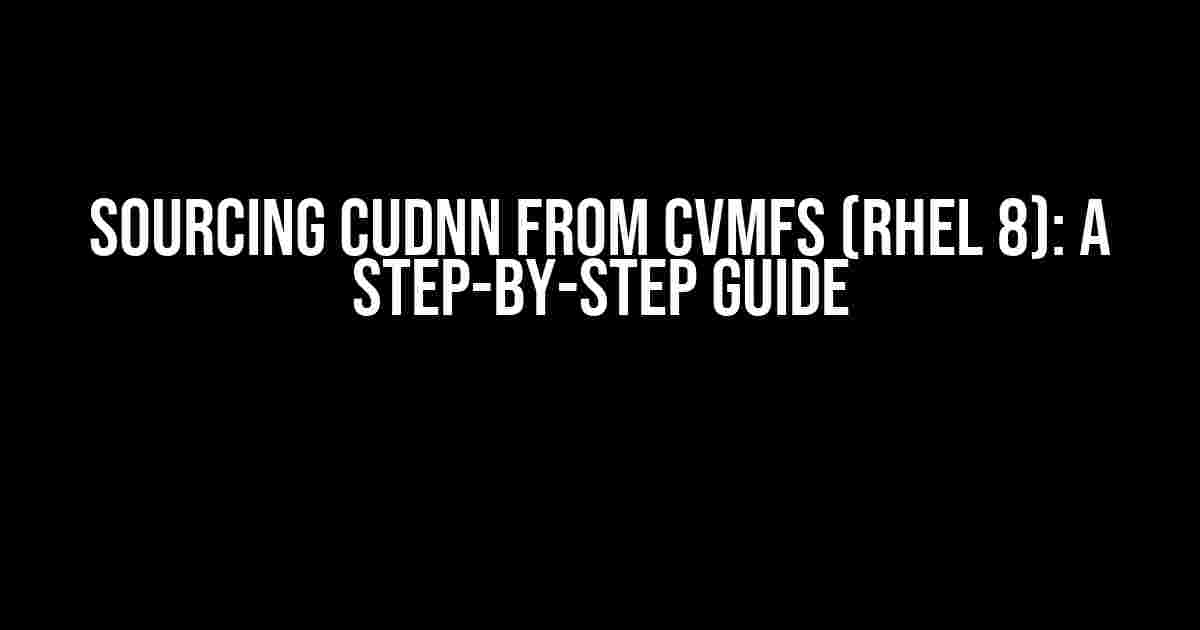Are you tired of struggling with cuDNN installation on your RHEL 8 system? Look no further! In this article, we’ll take you on a journey to sourcing cuDNN from CVMFS, a convenient and efficient way to manage software packages. By the end of this article, you’ll be able to install and utilize cuDNN with ease.
What is CVMFS?
CVMFS, or CernVM-FS, is a distributed file system that allows you to access a vast repository of software packages, including cuDNN. This system provides a convenient way to manage packages, eliminating the need for manual installation and management. With CVMFS, you can easily access and utilize the cuDNN library, a crucial component for deep learning frameworks like TensorFlow and PyTorch.
Why Source cuDNN from CVMFS?
There are several reasons why sourcing cuDNN from CVMFS is a great idea:
-
Easy installation: CVMFS simplifies the installation process, eliminating the need for manual downloads and configurations.
-
Version management: With CVMFS, you can easily switch between different versions of cuDNN, ensuring compatibility with your deep learning frameworks.
-
Centralized management: CVMFS provides a centralized repository for software packages, making it easy to manage and update packages across your system.
Prerequisites
Before we dive into the installation process, make sure you have the following prerequisites in place:
-
RHEL 8 system: Ensure you have a working RHEL 8 system with administrator privileges.
-
CVMFS client: Install the CVMFS client on your system. You can do this by running the following command:
sudo yum install cvmfs
Step 1: Configure CVMFS
To configure CVMFS, follow these steps:
-
Create a new file in the
/etc/cvmfsdirectory calleddefault.local. You can do this by running the following command:sudo touch /etc/cvmfs/default.local -
Edit the
default.localfile using your favorite editor (e.g.,sudo nano /etc/cvmfs/default.local) and add the following lines:[CVMFS] CVMFS_HTTP_PROXY="DIRECT" CVMFS_QUOTA_LIMIT="10000" CVMFS_REPOSITORIES="cern.ch" CVMFS_SERVER_URL="http://cvmfs-stratum-one.cern.ch/cvmfs/@fqrn@" -
Save and close the file.
Step 2: Mount CVMFS
To mount CVMFS, run the following command:
sudo cvmfs_config setup
This will configure and mount CVMFS on your system.
Step 3: Source cuDNN from CVMFS
Now it’s time to source cuDNN from CVMFS! Run the following command:
source /cvmfs/cern.ch/cuda/10.2/Linux/x86_64/10.2.2.89/cudnn-10.2.2.89/cudnn.sh
This will set up the cuDNN environment variables and configure your system to use cuDNN.
Verify cuDNN Installation
To verify that cuDNN has been successfully sourced from CVMFS, run the following command:
bazel query @local_cuda_cuda//visibility:public
This should output a list of CUDA and cuDNN-related packages, indicating that cuDNN has been successfully installed and configured.
Troubleshooting Common Issues
If you encounter any issues during the installation process, don’t panic! Here are some troubleshooting tips:
| Error Message | Solution |
|---|---|
Error: Unable to mount CVMFS |
Check that the CVMFS client is installed and configured correctly. Ensure that the /etc/cvmfs/default.local file is correctly formatted and contains the required configuration options. |
Error: cuDNN not found |
Verify that the cuDNN repository is correctly configured in the /etc/cvmfs/default.local file. Ensure that the cuDNN repository is included in the CVMFS_REPOSITORIES list. |
Conclusion
In this article, we’ve taken you on a journey to sourcing cuDNN from CVMFS on RHEL 8. By following these steps, you should now have a working cuDNN installation, ready to use with your deep learning frameworks. Remember to troubleshoot any issues that arise and don’t hesitate to reach out if you need further assistance.
With CVMFS, you can easily manage and utilize software packages, including cuDNN. Take advantage of this powerful tool to streamline your workflow and focus on what matters most – building innovative AI models!
Additional Resources
For more information on CVMFS and cuDNN, check out these resources:
-
CVMFS Documentation: https://cvmfs.readthedocs.io/en/stable/
-
cuDNN Documentation: https://docs.nvidia.com/deeplearning/cudnn/index.html
Happy coding, and see you in the next article!
Frequently Asked Question
Get answers to your most pressing questions about sourcing cuDNN from CVMFS on RHEL 8!
What is CVMFS and how does it relate to cuDNN?
CVMFS (CernVM-FS) is a read-only file system that allows for fast and efficient data access across a network. It’s commonly used in High-Performance Computing (HPC) environments. In the context of cuDNN, CVMFS provides a convenient way to source and manage cuDNN libraries, making it easier to deploy and maintain deep learning workloads on RHEL 8.
Why would I want to source cuDNN from CVMFS instead of installing it manually?
Sourcing cuDNN from CVMFS offers several benefits, including easier management, faster deployment, and reduced storage needs. With CVMFS, you can access the latest cuDNN versions without having to manually install and update them. This approach also helps reduce storage requirements, as you only need to store the necessary files locally.
How do I configure CVMFS to source cuDNN on RHEL 8?
To configure CVMFS on RHEL 8, you’ll need to install the `cvmfs` package, configure the CVMFS repository, and mount the cuDNN repository. You can then update your system’s environment variables to point to the CVMFS-mounted cuDNN directory. For a step-by-step guide, refer to the CVMFS documentation and NVIDIA’s cuDNN installation guide.
Can I use CVMFS to source cuDNN for GPU-accelerated workloads?
Yes, CVMFS is fully compatible with GPU-accelerated workloads. By sourcing cuDNN from CVMFS, you can leverage the power of NVIDIA GPUs for deep learning and HPC applications. Make sure to configure your system to use the correct GPU driver and cuDNN version for optimal performance.
Are there any specific system requirements for sourcing cuDNN from CVMFS on RHEL 8?
To use CVMFS for cuDNN on RHEL 8, your system should meet the minimum requirements for cuDNN and CVMFS. These include a compatible NVIDIA GPU, a supported RHEL 8 version, and sufficient storage and memory. Additionally, ensure that your system has the necessary dependencies installed, such as the `cvmfs` package and the required kernel modules.
